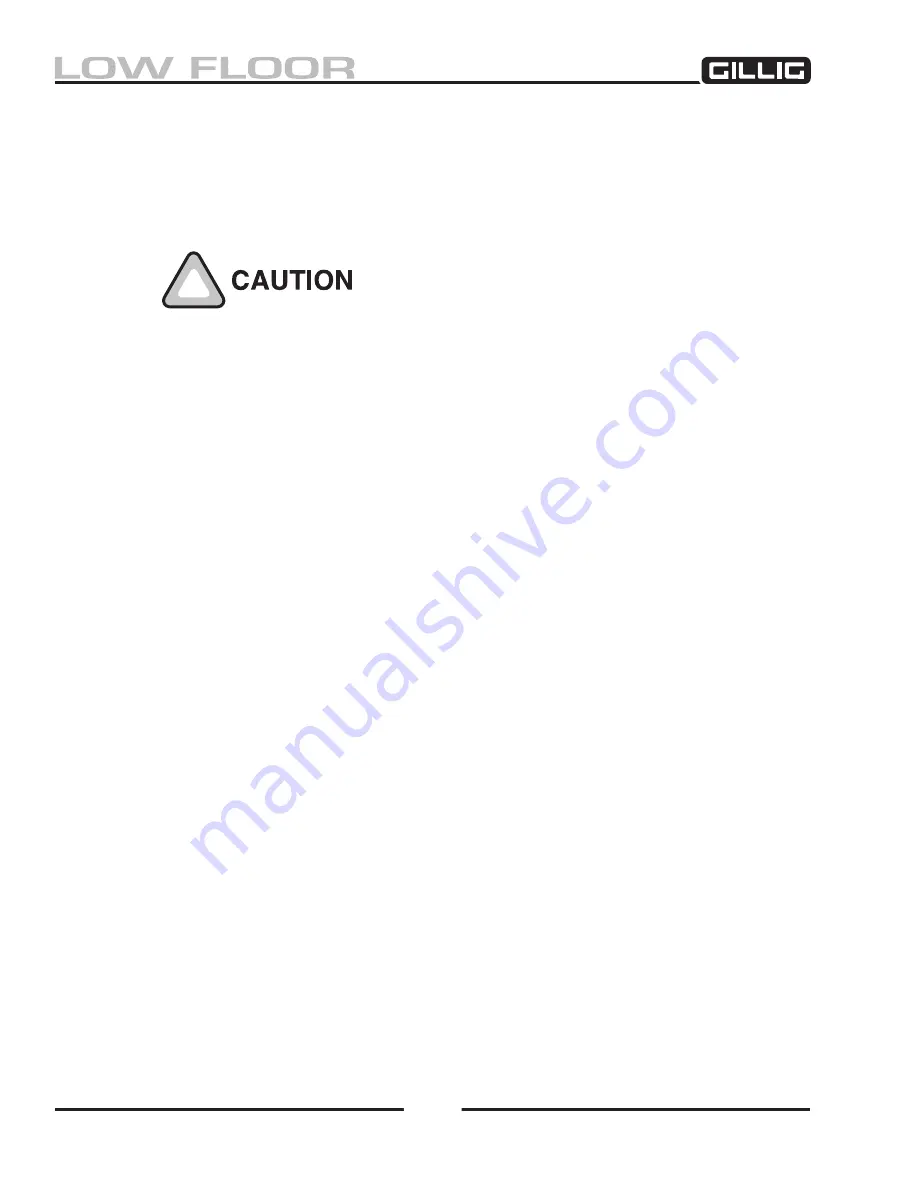
Body and Interior
464
Flooring
The flooring used is undercoated 3/4” preservative-impregnated, pressure-treated plywood or optional
composite panels, attached with industrial-strength adhesive/sealer and floor rivets. All surface irregular
-
ities are filled with fiberglass Bondo and sanded smooth. Rubber matting is cemented over the plywood.
Cleaning
When cleaning the floor, we recommend using a broom and mop, and
not a hose. We also recommend that caulking/sealer in flooring seams be
regularly inspected and maintained. Cracks in the flooring or at seams
can allow water or other liquids to seep through and damage the flooring
adhesive and the plywood floor. Any spilled liquids should be mopped
up as soon as possible.
All matting seams and joints must be kept sealed with floor sealer.
The plywood flooring can be de-
teriorated by excessive moisture, so matting should be resealed every three years.
The proper type
and color sealer can be purchased through the Gillig Parts Department.
To clean the bus floor, use a damp mop and a degreaser detergent with a PH of no more than 10 mixed
with warm water in a bucket, diluted as recommended by the detergent manufacturer. Apply the deter-
gent solution over the floor surface with a mop. Do not allow solution to completely dry on floor. Pick
up solution with a damp clean mop. Rinse flooring with a mop, using clean cool water to remove deter
-
gent.
Matting, Replacement
For safety, the flooring is covered with rubber or slip-resistant vinyl matting, which on some buses
includes a ribbed surface in the aisles. To replace damaged rubber or vinyl matting, remove all seats or
obstacles from the area to be repaired. Cut out and remove the damaged matting. Make sure the ply-
wood flooring is clean, dry, flat, and sanded smooth immediately prior to installation of floor covering.
Seal edges properly against moisture. All surface irregularities must be filled with a flexible patching
compound, such as Bondo. Cut a replacement piece of matting to fit, using the old piece as a pattern if
possible. Glue the new piece into place. All matting edges must be sealed with a floor sealer.
Plywood Flooring, Replacement
To replace the plywood or composite flooring, remove all seats or obstacles from area to be repaired.
Remove rubber matting and cut out damaged area of flooring. Cut a new piece of 3/4” plywood to fit the
damaged section and undercoat it with a water-base undercoating such as PPG CoraShield 7972. For an
exact fit, use the old flooring piece as a pattern when cutting the new flooring. Attach the flooring using
industrial strength contact cement. As explained above, fill in all exposed joints to provide a smooth,
uniform surface for the floor covering.
Summary of Contents for LOW FLOOR
Page 18: ...Specifications 18...
Page 58: ...Preventive Maintenance 58...
Page 110: ...Engine 110...
Page 138: ...Transmission Driveline Rear Axle 138...
Page 182: ...Suspension 182...
Page 260: ...Air System 260...
Page 420: ...Electrical System 420 Deutsch DT Series Connectors...
Page 421: ...Electrical System 421...
Page 422: ...Electrical System 422 Deutsch HD 10 Series Connectors...
Page 423: ...Electrical System 423...
Page 424: ...Electrical System 424 Deutsch HD 30 Series Connectors...
Page 425: ...Electrical System 425...
Page 442: ...Heating Air Conditioning 442...
Page 492: ...Body and Interior 492 Figure 11 33 USSC Seat Assembly...
Page 493: ...Body and Interior 493 Figure 11 34 USSC Seat Suspension Assembly...
Page 495: ...Body and Interior 495 Figure 11 37 Seat Air Connections...































